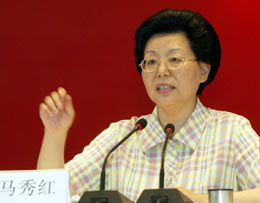|
Sino-Australian FTA study nears end
By Dai Yan (China Daily)
Updated: 2005-03-22 07:30
Vice-Minister of Commerce Ma Xiuhong revealed yesterday that a feasibility
study on a possible Sino-Australian Free Trade Agreement (FTA) will soon reach
its conclusion.
Ma told a symposium on the FTA that such an agreement between the two
countries would not only be mutually beneficial, but also "create new economic
impetus."
The study, which has been conducted for almost 18
months, will present a basis upon which both governments can consider the
benefits and costs of such an agreement.

Ma Xiuhong
[newsphoto/file] |
But should FTA talks begin, Ma stressed that China wants particular attention
to be paid to agriculture and services.
"China's agricultural industry is far weaker than Australia's. China has 740
million farmers and the further opening of this sector is a sensitive issue,"
she said.
She added that China's service sector is still adapting to the new industrial
landscape resulting from the opening of the sector in line with China's promises
to the World Trade Organization.
The study, announced as part of the trade and economic framework signed by
Australia and China in October 2003, was due for completion by October this
year.
Geoff Raby, deputy secretary of Australia's Department of Foreign Affairs and
Trade, expected the study to conclude by the end of this month.
Upon its conclusion, the study's recommendations will be submitted to both
governments.
Australian Prime Minister John Howard, who will visit China in April, has
said the nation will grant China market economy status if the FTA negotiations
are launched.
Australia-China Business Council Director Barry White said the FTA must have
a significant and positive impact on Australia's agricultural exports to China.
"China offers the most important growth opportunity for Australia exports for
the foreseeable future," said White.
Zhang Yunling, director of the Institute of Asia-Pacific Studies at the
Chinese Academy of Social Sciences, said it is reasonable to negotiate a FTA
between China and Australia because the feasibility study has proved it will be
mutually beneficial.
Australia is China's biggest supplier of wool, wheat and cotton. In 2004, 80
per cent of China's wool imports, and 70 per cent of its dairy imports came from
Australia, and cotton imports from Australia also increased threefold.
China is Australia's leading supplier of computers, and its third-largest
supplier of telecom equipment. Machinery, electrical goods and electronics
account for 56.3 per cent of China's exports to Australia.
"Such complementary benefits are built on a long-term base," Zhang added.
More long-term resource supply contracts will be signed and more joint
ventures will be undertaken in more areas, he said.
Australia will find a special advantage in an expanding Chinese market,
thanks to the nation's ever-increasing demand for raw materials, livestock and
agricultural products, Zhang pointed out.
The FTA will not only allow Australia improved access to the Chinese market,
but will also give it wider opportunities to tap into the East Asian market,
currently undergoing a process of integration, he said.
Australia was China's ninth-largest trade partner in 2004, and China was
Australia's third-largest trade partner last year.
Bilateral trade rose more than 50 per cent year-on-year to US$20.39 billion
last year.
China's exports to Australia stood at US$8.84 billion, reflecting an increase
of 41.1 per cent, while China's imports from the country reached US$11.55
billion, up 58.3 per cent year-on-year.
Australia's neighbour New Zealand has already started
FTA negotiations with China.
| |
 |
|
 |
|
|
Today's
Top News |
|
|
|
Top China
News |
 |
|
 |
|
|
|
|
|
|


